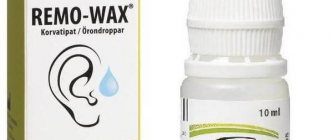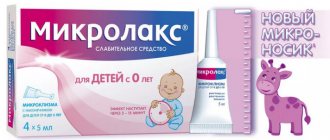Sulfur plugs often occur in people of any age. It must be removed from the ear canal, otherwise, in addition to hearing loss, other complications of the pathology will begin to develop. In addition to medical methods for removing a lump of compacted wax by washing the ear canal, using a vacuum device or a special instrument, there are also a number of medications that help with the problem. It is best, of course, to visit a doctor if there is a problem, but, as a last resort, you can try to use these medications yourself, but only taking into account all the contraindications.
Normally, wax, which is produced in the ear to cleanse the ear canal of bacteria, viruses, dust and foreign bodies, is itself released when a person chews, yawns or talks. If this process is disrupted, the secretion begins to accumulate in the ear cavity and is gradually compacted, which ultimately leads to the formation of a dense lump that completely blocks the canal and causes hearing loss and discomfort in the ear. The main reason for the development of a plug is improper ear hygiene, when cotton swabs or matches wrapped in cotton are used. They only push the secretion into the depths of the ear and compact it there, making its natural release impossible.
How to remove a cork at home
Removing ear plugs at home is a last resort, which can be resorted to only if there is no way to visit a doctor. If, after several attempts, a positive result has not been achieved, treatment on your own must be stopped and you must find an opportunity to contact an otolaryngologist.
There are three ways to remove a lump of wax from your ear yourself:
- washing the ear canal using an antiseptic solution and a syringe without a needle;
- phytocandles for sulfur plugs - they create a vacuum effect and thanks to this, like a vacuum cleaner, they pull out the plug;
- drops from earwax plugs - a special composition allows you to soften and dissolve the plug, after which it will be removed from the ear.
If these procedures are carried out carefully, they cannot cause harm. Unfortunately, if the plug is very dense, it may not be possible to remove it using home remedies. This phenomenon is most often observed if the lump is in the ear cavity for a very long time, or if it consists not of compacted wax, but of crumpled desquamated epithelial cells. In the latter case, the formation is tightly connected to the walls of the ear canal, and therefore removal of such a lump is possible only by a doctor using local anesthesia and further antiseptic treatment of damage to the ear mucosa.
How to remove an ear plug
It is strictly forbidden to try to remove wax plugs from your ears on your own using improvised means. This is fraught with injury to the skin of the external auditory canal, secondary infection, and perforation of the eardrum. It is better to entrust the procedure for removing the ear plug to an otolaryngologist. Depending on the consistency of the conglomerate, a specialist can choose one of the following methods for removing sulfur deposits:
- Dry. It involves removing sulfur using a special probe - a curette. This method is called curettage. It is indicated only for dry formations. A variation of the dry method is aspiration - removal of sulfur mass using electric suction with a soft consistency of the conglomerate.
- Wet. This includes several methods, such as:
- Rinse with warm water or saline sodium chloride solution using a Janet syringe without a needle.
- Dissolution by introducing special preparations into the external auditory canal that soften the sulfur.
Washing
Plasticine or paste-like sulfur plug can be removed by washing. The procedure is safe, takes no more than 10 minutes and proceeds as follows:
- The patient is seated on a chair, a towel and a kidney-shaped tray are placed on his shoulder to collect fluid.
- A short obliquely cut rubber tube is placed on the tip of the Janet syringe.
- Next, the doctor pulls the auricle up and back, thereby straightening the external auditory canal.
- Then the specialist directs a stream of water along the upper wall of the ear canal and, by gently pressing the piston, squeezes water into the ear. The liquid should have a temperature of about 37 degrees. This avoids the irritating effect of water on the nerve endings of the ear canal.
- The liquid flows back into the tray, washing away the wax.
- At the end of the procedure, the auricle is dried with cotton wool wrapped around the probe. This is a mandatory step, without which you can get a cold in your ears, which will lead to complications.
- Next, a turunda moistened with an antiseptic, for example, boric alcohol, furatsilin solution, Miramistin, is placed in the ear canal for 15-20 minutes.
The advantage of the method is the quick and painless removal of wax from the ears. Disadvantages include slight discomfort during the procedure and the possibility of damage to the ear canal if rinsing is performed incorrectly. Contraindications to this procedure include:
- perforation (violation of integrity) of the eardrum;
- sores, microcracks inside the ear;
- hearing loss;
- chronic otitis media
Dissolving the cork
This procedure has a special name – cerumenolysis. Its essence lies in the introduction into the external auditory canal of substances that soften or dissolve earwax . For this purpose, special drugs are used - cerumenolytics, which are divided into the following groups:
- Water-based products. These include Aqua Maris Oto, Chlorobutanol (Otinum), Glycerin (Bachon drops, En'jee ear drops), Triethanolamine. These drugs only soften sulfur, but do not solve the problem of large plugs that require mechanical intervention.
- Oil-based medicines. These are almond, rose, olive (Vaxol), mink (Remo-Vax) oils and mixtures of peanut, camphor and almond (Earex), paraffin (Clean-Irs). The effect of their instillation is to lubricate and soften the earwax, but it remains unbroken.
- Free from oil and water. This group includes hydrogen peroxide and urea. They only soften earwax.
- Surfactants. An example of this group of drugs is Cerumen-A. Its action is to adhere to the surface of the sulfur plug and destroy it. The reaction occurs due to hydration and cell lysis, which reduce the density of the conglomerate and promote its complete dissolution.
- Promoting the removal of earwax through vacuum. Phytocandles made from essential oils and beeswax have this property. They exhibit a local thermal effect and provide mild vacuum therapy.
The advantage of this technique is the simplicity of the procedure. Among the disadvantages, it can be noted that not every drug dissolves sulfur. Some of them only soften the conglomerate, so it must be removed by washing. The dissolution procedure has the following contraindications:
- Wax plug in the ear - causes, symptoms, diagnosis, removal by rinsing or dry method
- discharge from the ear;
- deformation of the eardrum;
- allergy to drug components;
- inflammation of the ear cavity.
The technology for dissolving earwax in the ears depends on the drug chosen. Peroxide is instilled in a lying position on the side, 3-5 drops. The procedure is repeated 2-3 days up to 5 times a day. Special preparations for dissolving cork are used differently. For example, Cerumen-A is used according to the following instructions:
- Open the ampoule by turning its upper part.
- Tilt your head so that the ear with the plug is in a horizontal position and higher than the other.
- By pressing the bottle once, inject the solution into the ear canal.
- Maintain your head position on your side for one minute.
- Then press it to your shoulder so that the remaining drug flows out.
- Wipe the ear with dry, clean cotton wool.
- Use morning and evening for 3-4 days - this is how long the procedure for removing wax from the ear will last.
Dry removal
When the formation has a dense structure and cannot be removed by washing, as when foreign bodies get into the ear, dry instrumental removal methods are used . The first of them is vacuum aspiration. This procedure involves suctioning out secretions using special devices that create negative pressure in the ear cavity. The aspiration technology is as follows:
- The patient is seated on a chair, and a suction tube is inserted into the external auditory canal.
- Next, turn on the aspirator, on which the doctor has already set negative pressure.
- After a couple of minutes, the doctor examines the ear canal to ensure that the conglomerate has been completely removed.
Among the disadvantages of aspiration is the loud sound during the procedure. In addition, some patients develop vestibular disorders in the inner ear, resulting in dizziness, nausea, and vomiting. The advantage is the possibility of performing aspiration in patients with defects of the eardrum. Contraindication – hard sulfur plug.
Another dry method is curettage, in which sulfur is removed mechanically . This method is indicated when washing is ineffective. The advantage of curettage is that it can be performed in patients who have previously suffered from purulent otitis, have perforation of the eardrum, or hearing loss. The disadvantage of the technique is pain, which is why the procedure is often performed under local anesthesia. The curettage technology is as follows:
- The doctor pulls the patient's ear up and back.
- Next, under optical control, a specialist inserts a hook, tweezers or a small spoon into the ear and removes the wax.
- After the procedure, a cotton swab moistened with an antiseptic or antimicrobial solution is placed in the ear canal for 15-20 minutes.
Drops
Drops for removing wax plugs from the ears are the gentlest and safest remedy for people of any age. There are medications even for children from birth. The only limitation to the use of such a remedy is the violation of the integrity of the eardrum. There are several of the most popular drugs that are extremely easy to use and effective in most cases. When an accumulation of wax appears in the ear, you should pay attention to the following compounds:
- Remo-Vax - these drops are capable of dissolving even fairly hard caked plugs that are not susceptible to other drops. In this case, the plug is released in parts without any damage to the ear tissue. Using the drug is completely painless and does not cause any discomfort. The main composition of the drops is penetrants, which quickly dissolve dead skin particles in the plug and dilute the sulfur. The drug also contains substances that help to thoroughly moisturize the ear canal and wash out particles of plug from it. There are no aggressive components or antibiotics in the drug, which makes it safe and mild;
- Vaxol - these drops not only help dissolve the wax plug, but also prevent its reappearance. The main composition of the drug is medical olive oil, which not only softens and removes the plug, but also moisturizes the ear canal, and also softens the tissue, restoring the proper functioning of the glands that produce sulfur. It will take at least 5 days to use such drops for a traffic jam. For prevention, it is enough to use the product 2-3 times a week. One bottle of the drug is enough for 200 instillations;
- A-Cerumen - drops that carefully remove plugs and are suitable even for small children. For adults, this medicine will also be useful if a lump of sulfur appears. Dissolution of the foreign body occurs due to the presence of surfactants in the composition. The drug also has a moisturizing and softening effect. Using the product, like other drops, is easy.
It will take some time to remove the plug using drops. The cork cannot be removed with drops in one day. On average, it takes from 2 to 5 days to achieve a therapeutic effect. Every day, once or twice a day, depending on the instructions, drops are placed in the ear and left for 3 minutes or more, in accordance with the instructions for the drug. During this time, the patient should lie on his side with the blocked ear facing upward. After the required time has passed, you should apply a piece of clean cotton wool to your ear and stand up, tilting your head towards the dripped ear. Drops containing parts of the dissolved plug will flow out. Several such procedures will help clean the ear canal completely. If you are prone to the formation of traffic jams, it is useful to use drops for prevention. Often, drops in the ear to dissolve wax plugs can also be prescribed to care for the ears of infants.
Why do some people have wax plugs and others don’t?
It all depends on individual characteristics.
Main reasons:
- a person does not properly care for his ears: he cleans them with cotton swabs not only outside, but also inside. So he pushes the wax into the ear;
- There are people with tortuous ear canals. This structure promotes the accumulation of sulfur masses;
- too much wax is formed, the ear does not have time to cleanse itself.
Medical offers to make an appointment with an otolaryngologist (ENT) of the highest category. A full range of diagnostics and treatment of ENT diseases in Tula. Tel. for recording.
Phytocandles or funnels
This medicine for wax plugs can be bought at a pharmacy. When used correctly, it will not cause any discomfort and will not only remove the plug from the ear, but will also prevent the development of inflammation, and will also have a calming effect on the nervous system. The funnel, which is also called a candle, during the combustion process will create the necessary draft to remove the plug and will warm up the sore ear. It is useful to use this remedy not only for traffic jams, but also for inflammation, when heating is allowed. Candles can improve the health of the ear, but only if there is no purulent process, damage to the ear canal, damage to the integrity of the eardrum, otitis, fungal infection or allergy to wax.
The patient lies on his side with the ear in which the plug is located facing up. They cover his head with a cloth so that only his ear is exposed. A phyto-funnel (phyto-candle) is inserted into the auditory canal with its narrow end and set on fire. The cut should burn to the level marked on it by the manufacturer. They extinguish it in water, preventing it from burning any more. If you unwrap the rest of the candle, you will see an elongated plug in it. Thanks to the heat, the wax softens well, and the vacuum effect removes it from the ear canal. This procedure also helps improve nasal breathing, which is useful for viral infections.
How to remove an ear plug at home: methods and tips
Video on how to remove the plug yourself:
There are several options for removing an ear plug yourself.
These methods are recommended to be carried out only after consultation with a specialist and in strict accordance with the instructions for the drug.
Hydrogen peroxide
It is easy to remove stagnation yourself at home using hydrogen peroxide. This method is considered the simplest and most accessible. 3% hydrogen peroxide is used. If the solution is of higher concentration, the possibility of a chemical burn cannot be ruled out. 2-3 drops of solution are dripped into the ear using a pipette. In this case, the patient should lie with his head with the second ear on the pillow.
- Earwax in the ear: symptoms, removal at home
After this, a slight hissing and burning sensation will be felt in the ear - this is normal. You need to stay in this position for 10–15 minutes. After this time, turn your head to the other side and place a napkin under your ear. If everything went well, the remainder of the peroxide with pieces of wax will flow out of the ear. Such manipulations must be repeated three times a day for 3 days. This is due to the fact that it is not possible to completely remove the plug in one procedure.
If pain occurs, you should immediately get up and try to pour the remaining solution out of your ear, and then go to see a specialist.
Drops
This option is considered not only effective, but also safe. It can also be used to remove ear plugs in young children. To do this, you need to lie on your side on a pillow and drop the number of drops of solution specified in the instructions into the ear canal. After 3 minutes, the drug will completely dissolve the sulfur. It can be removed from the passage by simple washing.
Candles
You can get rid of sulfur stagnation using special candles. They can be purchased ready-made at the pharmacy, or you can make them yourself from propolis, beeswax or medicinal herbs.
There are several types of herbal candles: with propolis, herbal, essential. Their advantage is that they contain natural components that do not have a negative effect on the mucous membrane.
To remove the plug with phyto-candles, you need to first treat the ear shell with baby cream and cover it with a small napkin with a hole. After this, light the upper part of the candle and place the lower edge to your ear. After a third of the candle burns out, dip the rest into a glass of water. Wipe off any remaining candles. Insert a tampon into the ear canal.
After 5-10 minutes, the congestion will soften and come out of the ear. The essence of the action of a candle is that during combustion, heat and vacuum are formed, which promotes softening and removal of sulfur.
Ear blowing
Some people decide to remove or break through stagnant sulfur at home by blowing it out on their own.
This option is considered the most dangerous and is used in case of emergency upon the recommendation of a specialist.
- “Earwax in children can lead to hearing loss”
Several methods of blowing are known:
- Valsalvas;
- Toynbee;
- Politzer.
At home, it is possible to use only the first method (Valsalva). Its essence is that the patient needs to take a deep breath and, holding his nose, try to exhale the air. Coming from the lungs, air under pressure enters the Eustachian tube, from where it is directed to the eardrum. This leads to the squeezing out of stagnation.
Hydrogen peroxide
In most cases, hydrogen peroxide can even cope with a dense plug, which requires strong softening, which a phytocandle is not capable of. The use of this remedy may not be very pleasant, as it often causes discomfort and burning, but it is effective and helps prevent infection. In addition to a 3% peroxide solution, cotton wool is required for the procedure.
The patient lies on his side with the blocked ear up and pours a few drops of peroxide into it. It is required to remain in this position for a quarter of an hour. This time is enough to dissolve the plug. During this process, hissing and foam formation occur. It is also possible that severe deafness may occur, which should not frighten you - your hearing will return after the plug is removed. When the effect of the peroxide ends, the patient, applying cotton wool to his ear, turns over to the other side and allows the liquid to flow out. If the plug is not completely removed, then the antiseptic is refilled. The sulfur plug and peroxide usually come out quickly after this.
How to remove a plug by washing
Dried sulfur must be softened.
To do this, use a solution of baking soda (3%) or hydrogen peroxide. For two days, drops are applied to the ear three times a day. Then wash the plug out of the ear using a syringe or syringe. Read also: Otosclerosis How to remove the plug correctly:
- Tilt your head over a basin or sink so that water flowing from your ear does not get on your clothes or floor.
- Fill the syringe with warm boiled water (not hot), squeeze out the air and gradually pour water along the ear wall.
- Wax from the ear should be washed out until all the plug is removed from the ear and the discomfort from its presence goes away.
Washing
The procedure is carried out using a large-volume syringe, as well as saline or antiseptic solution. The second option is better, as it will prevent inflammation from occurring due to infection. As an antiseptic solution for washing, it is best to use a weak solution of manganese or a solution of furatsilin, prepared at the rate of 2 tablets per 1 liter of water.
Before washing the ear, wipe it with chlorhexidine. After this, bending over the sink with the affected ear down, pour liquid into it in small portions. There should be no pain during this procedure. When it appears, rinsing is stopped immediately. If it is not possible to wash the cork three times, stop trying to remove it on your own.
The main symptoms of wax plug
Often, the patient may not realize that there are wax plugs in the ears, because they do not present any particular discomfort. However, symptoms such as tinnitus, autophony (resonance of one's own voice), a feeling of fullness and, finally, severe hearing loss signal the formation of earwax.
Often, when water gets into the ear, the wax mass swells and completely blocks the ear canal. If the formed plug is located near the eardrum, irritation of the nerve endings occurs and the patient may feel nausea, dizziness and headache.
It is also worth remembering that due to prolonged irritation of the eardrum, inflammatory processes may develop in the middle ear, where our hearing aid is located.
Removal of wax plug (ear lavage) – City Med Clinic Orenburg
Earwax is a substance produced by modified sebaceous glands located in the skin of the external auditory canal.
Its role is to protect the ear canal from dust, water, small particles, microorganisms (viruses, bacteria, fungi) that can penetrate the ear with water or air. There should always be a small amount of sulfur in the ear canal - this is a natural protection of the internal structures of the ear from external aggressive and pathogenic agents. Sulfur plug in Latin is called cerumen. The name "cerumen" is derived from the term "ceruminous glands", which in Latin means "glands that produce sulfur." Any cerumen plug is an accumulation of sulfur and dead cells of the desquamated epidermis (lining the ear canal), which can be mixed with fungal casts and pus. The wax plug is always located in the external auditory canal of one or both ears and, accordingly, clogs it completely or partially, which gives the name to this formation. Types, prevalence and general characteristics of wax plugs in the ear Wax plugs are essentially a lump of earwax mixed with desquamated epidermal cells. All components in the ear canal stick tightly together, forming a lump. This lump partially or completely covers the external auditory canal, depending on its size and location. The consistency of wax can vary, ranging from soft and runny, similar to honey, to dense and hard, like stone. Depending on the consistency of the wax plug, the following types are distinguished:
- Paste-like sulfur plugs are colored light yellow or dark yellow and have a soft, moderately fluid consistency, reminiscent of fresh honey;
- Plasticine-like sulfur plugs are colored in various shades (from the lightest to the darkest) of brown and have a viscous but pliable consistency that can be given any shape;
- Solid sulfur plugs are dark brown or black in color and have a hard and dense consistency. To the touch, such sulfur plugs are dry and look like stones or pieces of earth.
Moreover, any sulfur plug in the process of its development goes through all of the above stages in turn, first being paste-like, then becoming plasticine-like, and finally turning into solid. Initially, any cork has a paste-like consistency. Subsequently, the consistency of the plug depends on how long it remains in the ear canal. The more time the plug was in the ear canal, the denser its consistency. Accordingly, hard wax plugs are lumps of wax that have been “lying” in the ear for a long time, while paste-like ones have formed quite recently. Depending on the location and volume, the cerumen plug can be parietal or obturating. The parietal wax plug is attached to any one wall of the ear canal and only partially covers its lumen. The obturating cerumen plug completely closes the lumen of the ear canal. In addition, there is a special type of sulfur plug, which is called epidermal, because it is formed from crumpled cells of desquamated epithelium. This plug is hard as a stone, painted white or light gray and is very tightly attached to the walls of the ear canal. Due to its tight attachment to the walls of the ear canal, the epidermal plug is difficult to separate and can provoke the formation of bedsores in the narrow bony part in front of the eardrum. Ear plugs occur with equal frequency in people of both sexes of any age. This means that wax plugs are equally common in children and adults, as well as in women and men.
Do you even need to clean your ears?
It is believed that the ear is a self-cleaning organ. This is partly true: sulfur, which everyone is trying to remove as thoroughly as possible, actually has a protective function. It prevents infections, dust, and water from entering the ear canals. By removing sulfur, you destroy the protective barrier. In a healthy body, this substance should be released as much as needed, and its excess should flow into the ears and be washed away during the shower. However, under certain circumstances there is too much sulfur:
- infectious diseases;
- increased sweating;
- inflammatory processes in the middle ear;
- increased blood cholesterol levels;
- chronic stress, which increases the secretion of the ceruminal glands;
- constantly wearing headphones.
In addition, more sulfur is released in the hot season, in poor environmental conditions or in a large amount of dust in the room.
How to remove wax plug with medication
In modern pharmaceuticals there are various means to remove sulfur plugs. These drugs dissolve dried sulfur, and it comes out naturally. A very popular product is Remo-Vax.
The constituent substance allantoin completely dissolves wax and cares for the outer ear canal. This drug can be used by anyone who has increased sulfur formation.
To clean the canal, you can use Remo-Vax once a week. In this case, there is no risk of plug formation. The medicine is not an antibiotic and can be used for children.
There is another well-known remedy - Nycomed. These drops are designed to remove wax buildup. If you put drops in your ear, the wax does not swell, but dissolves and comes out on its own. One bottle of the drug is designed to clean one ear.
The drops can also be used by children; they are absolutely safe and their composition does not irritate the ear canal. For ear diseases, you should consult a doctor; for otitis media, drops should not be used.
You can purchase phytocandles or phytofunnels. They are available and safe; the main substance in the candles is propolis.
General information about pathology
The composition of the wax plug in the ear is formed from the secretion of the skin glands of the external auditory canal. The basis of sulfur is sebum and secretions of the corresponding glandular tissues. Over time, particles of keratinized epithelium and secretion products of apocrine sweat glands are added to them. The color of the substance may vary depending on the dominant element, the age of the patient, the characteristics of metabolic processes in the body, the intensity of physical activity, and the presence of chronic or systemic pathologies.
The main function of the secretion of the glands located in the external auditory canal is to protect the tissue from damage, excessive drying or softening when exposed to water. The acidic environment of sulfur secretions provides an antiseptic effect upon contact with bacteria and fungi, which prevents the development of external otitis. During chewing, speaking and during bouts of yawning, sulfur moves to the outer opening of the ear canal, providing mechanical cleaning of the canal from dirt, dust particles, and small foreign bodies. The formation of wax plugs in adults and children disrupts the functioning of the protective mechanisms of the ear.
Hydrogen peroxide (or peroxide)
Using peroxide 3% is the most effective way to get rid of excess sulfur and dissolve cerumen plugs. It is also used by ENT doctors. You shouldn’t get carried away, since peroxide is quite an active substance. With its frequent use, the surface of the sink becomes dry, which leads to a disruption in the protective balance of the skin. Without wax, the ear becomes defenseless against infections.
How to properly clean your ears with peroxide? You need to drop the solution into the solution using a pipette (5-7 drops), tilting your head to the side and pulling the earlobe. Try to keep your ear canal upright - it's best to lie on your side while the peroxide and wax interact. The process will cause a hissing sound, which should not be feared.
After a couple of minutes, the reaction will end and the ear can be washed with warm water (36-37 degrees) or herbal decoction. Having collected the liquid into the syringe and leaned over the sink, you should spray it into the canal by sharply pressing the bulb. This creates a pressure that washes away the remaining sulfur. Caution is needed here! Strong pressure can damage the eardrum. The procedure must be done extremely carefully. Repeat the process if necessary.







![Table 1. Dynamics of publications on clinical trials of piracetam and piracetam-like drugs over four time periods [5, with additions]](https://laram-halal.ru/wp-content/uploads/tablica-1-dinamika-publikacij-posvyashchennyh-klinicheskim-ispytaniyam-piracetama-i-piracetamopodobnyh-330x140.jpg)
